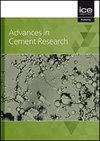Fingerprinting Portland cements by means of 87Sr/86Sr and 143Nd/144Nd isotope ratios and geochemical profiles
IF 1.3
4区 工程技术
Q3 CONSTRUCTION & BUILDING TECHNOLOGY
引用次数: 0
Abstract
This study uses conventional 87Sr/87Sr and 87Nd/87Nd isotope and interelement ratios of Ca, Sr, K, Mn, Mg, and Ti as fingerprints for ordinary Portland cements (OPC) provenancing. Herein, the first database of Sr and Nd isotope ratios investigated in OPCs stemming from twenty-nine cement plants located worldwide was created. The results show that the Sr isotope ratios of OPCs are higher than those of seawater from the observed geological period. The spread of 87Nd/87Nd in OPCs is not as large as the spread for 87Sr/87Sr isotope ratios. However, the combination of both Sr and Nd isotope ratios provides the potential for distinguishing between cements of different production sites. Most of the investigated OPCs have measurable differences in their 87Sr/87Sr and 87Nd/87Nd isotope ratios, which can be employed as a valuable analytical fingerprinting tool. In the case of equivocal results, Divisive Hierarchical Clustering was employed to help overcome this issue. The construction of geochemical profiles allowed computing suitably defined distances between cements and clustering them according to their chemical similarity. By applying this methodology, successful fingerprinting was achieved in 27 out of 29 analysed ordinary Portland cements.利用87Sr/86Sr和143Nd/144Nd同位素比值及地球化学剖面对硅酸盐胶结物进行指纹鉴定
本研究使用常规的87Sr/87Sr和87Nd/87Nd同位素以及Ca、Sr、K、Mn、Mg和Ti的元素间比率作为普通硅酸盐水泥(OPC)的指纹。在此,创建了第一个研究来自全球29家水泥厂的OPCs中Sr和Nd同位素比率的数据库。结果表明,从观测到的地质时期来看,OPCs的Sr同位素比值高于海水。87Nd/87Nd在OPCs中的分布不如87Sr/87Sr同位素比值的分布大。然而,Sr和Nd同位素比率的组合提供了区分不同生产地点的水泥的潜力。大多数研究的OPCs在87Sr/87Sr和87Nd/87Nd同位素比率方面都有可测量的差异,这可以作为一种有价值的分析指纹工具。在结果模棱两可的情况下,采用了划分层次聚类来帮助克服这个问题。地球化学剖面的构建允许计算水泥之间适当定义的距离,并根据其化学相似性对其进行聚类。通过应用这种方法,在29种分析的普通硅酸盐水泥中,有27种获得了成功的指纹图谱。
本文章由计算机程序翻译,如有差异,请以英文原文为准。
求助全文
约1分钟内获得全文
求助全文
来源期刊

Advances in Cement Research
工程技术-材料科学:综合
CiteScore
3.70
自引率
5.00%
发文量
56
审稿时长
3.2 months
期刊介绍:
Advances in Cement Research highlights the scientific ideas and innovations within the cutting-edge cement manufacture industry. It is a global journal with a scope encompassing cement manufacture and materials, properties and durability of cementitious materials and systems, hydration, interaction of cement with other materials, analysis and testing, special cements and applications.
 求助内容:
求助内容: 应助结果提醒方式:
应助结果提醒方式:


